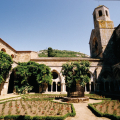ABBAYE DE FONTFROIDE
Fontfroide Abbey in Narbonne, an incredibly well-preserved abbey that organises numerous events and produces its own wine
Just 10 minutes from Narbonne, in the heart of a vast, wild and protected massif, visit Fontfroide Abbey, a treasure trove of the Middle Ages. Founded in the late 11th century, Fontfroide joined the Cistercian order in 1145 and became one of the most powerful abbeys in France. In the Middle Ages, up to 80 Cistercian monks lived here within the confines of the abbey. Only the lay brothers are allowed to leave, to work on the farms that support the monastery. Although they also have religious status and are bound by monastic vows, the lay brothers form a second community. They work for the monks in exchange for room and board, and live in another wing of the monastery. The abbey played a crucial role in the crusade against the Cathars, before suffering a long decline from the 14th century onwards. The monastic complex has been magnificently preserved, with its 12th-century cloister and chapter house, sumptuous abbey church with modern stained-glass windows, lay brothers' buildings and 17th- and 18th-century fittings that sometimes give it a château-like feel. Extensive terraced gardens surround the abbey. In 1908, Gustave and Madeleine Fayet bought Fontfroide and began restoration work. Artists, known as Fontfroidiens, took part in the artistic renaissance of Fontfroide, including Odilon Redon, Richard Burgsthal, Déodat de Séverac, Ricardo Viñes and Aristide Maillol. They created a kind of "Villa Médicis" here, embellished with decorative elements. Abandoning its status as a monastic site to become a true place of artistic expression, Fontfroide Abbey is imprinted with rich testimonies to these residences, including Richard Burgsthal's stained glass windows in the abbey church and Odilon Redon's paintings Le Jour, la Nuit et le Silence, recently classified as Historic Monuments, in Gustave Fayet's former library.
Today, the descendants of Gustave and Madeleine Fayet continue to maintain the monastic complex. Over 100,000 visitors discover the abbey every year. As you explore the various rooms, bathed in sunlight, adorned with works of art and filled with the whispers and laughter of curious families, it's hard to imagine the Cistercian austerity that reigned here when the monks still occupied the premises. The abbey was immersed in total silence, interrupted only by the reading of holy texts. During a guided or self-guided tour, visitors can immerse themselves in the world of Fontfroide and explore every nook and cranny, soaking up the abbey's atmosphere and gaining an insight into the daily life of the Cistercian monks. Here are a few architectural highlights not to be missed:
The cloister. Comprising several vast, light-filled galleries, it bears witness to two distinct construction periods, the 12th and 13th centuries. The lower part of the cloister is Romanesque, while the upper part is less austere, in the Gothic style. The capitals of the columns, which date from the Romanesque period, are covered with plant motifs, human or animal representations having been forbidden by the Cistercian order so as not to distract the monks.
La ruelle des convers. The converses had to use this narrow passage to attend Sunday mass, so as not to disturb the monks, who accessed the church via the cloister. Fontfroide Abbey is one of the few Cistercian abbeys to have preserved its "ruelle des convers" in its original state. It can be recognized by its unique half-barrel vault.
The rose garden. Located behind the church on the former monks' cemetery, the rose garden adjoins the terraced gardens, which have been awarded the "jardins remarquables" label and the LPO Refuge label.
Throughout the year, Fontfroide offers a wide range of exciting events: Gregorian chants at Easter, the Fête des Plantes et du Massif, medieval festivals in May, the Festival Musical et Histoire with Jordi Savall in July, a major orchid exhibition and sale in October... Check out the online calendar for full details. For gourmets, head to the Caveau de dégustation and sample the various flavors of the south, with "Fontfroide" products developed in partnership with local producers. Gastronomes will enjoy a gourmet break at the Restaurant de Fontfroide, in the former sheepfold at the entrance to the abbey, where chef Yohan Renard prepares his cuisine. After this break, a stroll along the paths of the Massif de Fontfroide is a must, offering breathtaking views of the thousand-year-old heritage (unless the massif is closed due to fire risk). The abbey is sometimes used as a film set, including scenes from Ridley Scott's The Last Duel (2021).
The treasure hunt. In this thousand-year-old abbey, a fabulous secret is fiercely guarded. It's the secret of the perfect rose. Thanks to the Brotherhood of the Rose's equipment, you'll be able to discover the ingredients you need to grow this famous rose, which, according to an old legend, can fulfill the wishes of whoever plucks it.
The kit can be hired from the abbey reception desk. Length of tour: 1h15.
Did you know? This review was written by our professional authors.
The strengths of this establishment:
Book the Best Activities with Get Your Guide
Members' reviews on ABBAYE DE FONTFROIDE
The ratings and reviews below reflect the subjective opinions of members and not the opinion of The Little Witty.
Find unique Stay Offers with our Partners







La visite est bien documentée et interactive (prêt de tablette contre une pièce d'identité). Il vaut mieux télécharger l'application à la maison, car pas de réseau sur place.
Grand parking gratuit et toilettes impeccables.
Cependant, il manque un supplément d'âme à cette abbaye qui est vide, puisqu'aucune communauté monastique n'y vit.